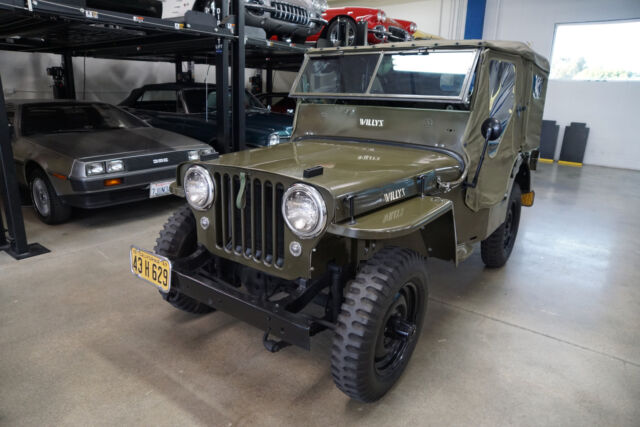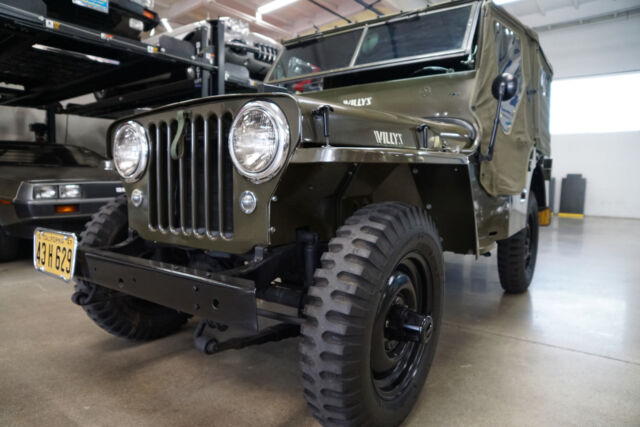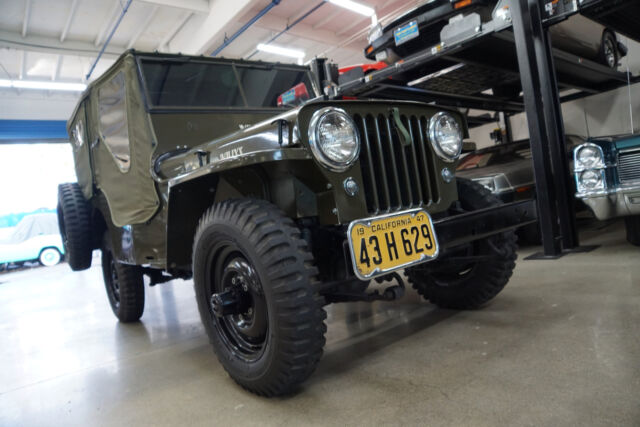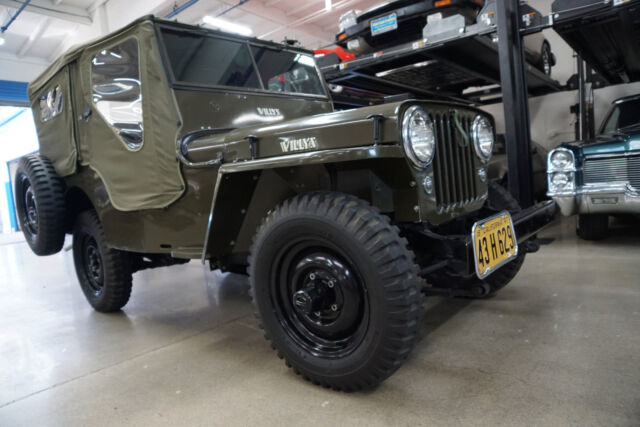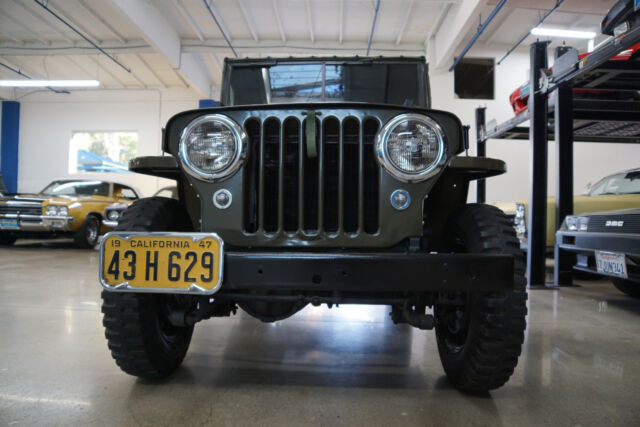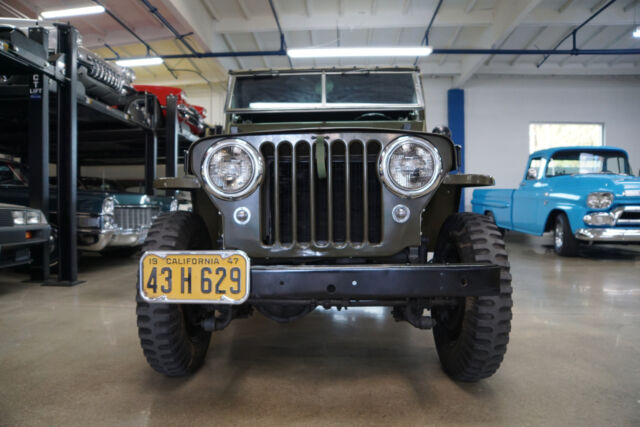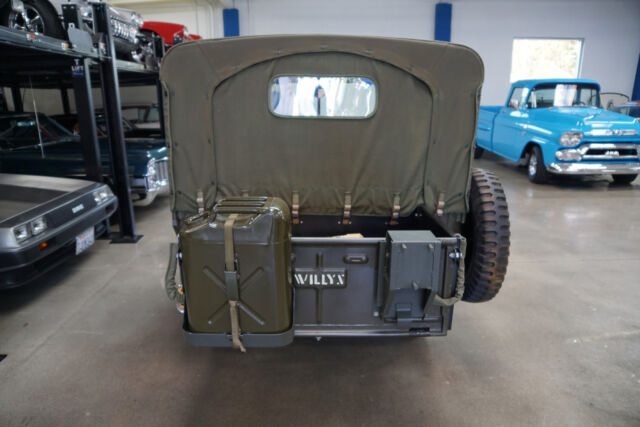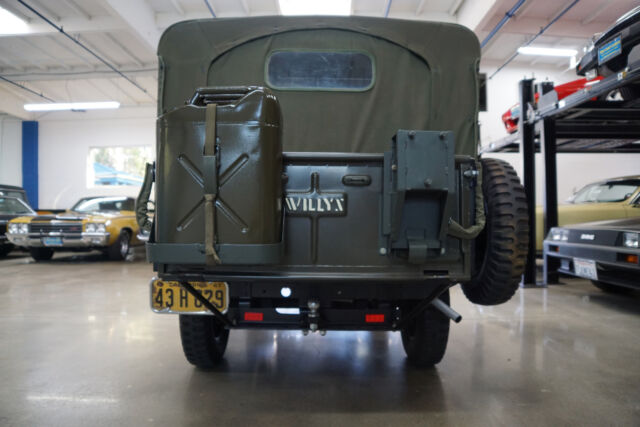0 4 cyl 134 cid 60hp Manual
- Condition: Used
- Make: Willys
- Model: Jeep CJ2A Universal
- Type: --
- Trim: --
- Year: 1947
- VIN: CJ2A137954
- Color: Green
- Engine size: 4 cyl 134 cid 60hp
- Power options: --
- Fuel: Gasoline
- Transmission: Manual
- Drive type: --
- Interior color: Green
- Options: --
- Vehicle Title: Clear
- Location: Torrance, California, United States
Description
West Coast Classics are proud to present an absolutely exceptional example of this apparently unrestored original southern California example and extraordinarily well preserved 1947 Willys Jeep CJ2A in traditional US Military colors with it's 134 L head 4 cylinder "Go Devil" engine and full soft top & bikini top.The mighty Willys MB emerged out of the cauldron of war ready for peace time service. The legendary G.I. workhorse of World War II was converted by Willys-Overland into a CJ with... the aim of putting farm workhorses out to pasture. This was the first civilian brand Jeep.According to Willys-Overland, there were 5.5 million farmers in the U.S., and of these, more than 4 million had neither a truck nor a tractor. The rugged and versatile CJ-2A was marketed by Willys-Overland as "The All-Around Farm Work-Horse". It could do the job of two heavy draft horses, operating at a speed of four miles per hour, 10 hours a day, without overheating the engine. The CJ-2A "Universal" was to serve agriculture and industry all over the world in a thousand different ways.With the close of WWII now eminent, Willys-Overland began to consider the development of a civilian jeep that it could market beyond the scope of the militarized MB, leading to the first mass-production of the CJ-2A in 1945. First drafts of the CJ-2A included the CJ-1 and CJ-2 (AgriJeep), of which only 6 are known to have survived.The CJ-2A resembled its military ancestor closely, with a tailgate and side mounted spare tire. However, there are certain characteristics of the CJ-2A that make it easier to distinguish from the Willys MB; most notably with regard to the headlights (which on the CJ-2A are larger and flush-mounted) and the grille (now a seven-slot grille as opposed to the nine-slot MB grille). The CJ-2A T-90 Transmission replaced the MBs T-84, while the "Go-Devil" engine was kept intact - many of the early CJ-2As were equipped with surplus parts leftover from wartime production.Willys Overland first marketed the CJ-2A with the intention of gaining ground in farming, ranching, and other industrial and agricultural applications. Options were abundant on the CJ-2A, including extra equipment such as a rear seat, center rear view mirror, front passenger seat, canvas top, front PTO, rear PTO, belt pulley drive, capstan winch, governor, rear hydraulic lift, snow plow, welder, generator, mower disc, front bumper weight, heavy duty springs, dual vacuum windshield wipers, dual taillights, hot-climate radiator, driveshaft guards, heater, side steps, and radiator brush guard. In 1949, the Willys-Overland replaced the CJ-2A with the CJ-3A, which was produced until 1953.General Eisenhower had wrote that the Jeep was "one of the six most vital" U.S. vehicles to win the war.The design of the World War II jeep was the result of a long process, involving the contributions of both U.S. military officers and civilian engineers. The idea of the Jeep originated with the infantry, which needed a low, powerful vehicle with four-wheel drive the latter were mostly tied to three companies: Bantam, Willys and Ford, and the development has repeatedly been called a "design by committee". In fall 1941, Lt. E.P. Hogan of the U.S. Quartermaster Corps wrote: "Credit for the original design of the Army's truck 1⁄4-ton, 44, may not be claimed by any single individual or manufacturer. This vehicle is the result of much research and many tests." By July 1941, the War Department desired to standardize and decided to select a single manufacturer to supply them with the next order for 16,000 vehicles. Willys won the contract mostly due to its much more powerful 60 HP engine (the "Go Devil"), which soldiers raved about, and its lower cost and silhouette. The design features in the Bantam and Ford entries which represented an improvement over Willys's design were then incorporated into the Willys car, moving it from an "A" designation to "B", thus the "MB" nomenclature. Most notable was a flat wide hood, adapted from Ford GP.The Jeep, once it entered mass production, introduced several new automotive technologies. Having four-wheel drive for the first time introduced the need for a transfer case, and the use of constant-velocity joints on the driven front wheels and axle, to a regular production car sized vehicle.By October 1941, it became clear that Willys-Overland could not keep up with production demand, and Ford was contracted to build Jeeps as well, using Willys blueprints, drawings, specifications, and patents, including the Willys engine. The Ford car was then designated "GPW", with the "W" referring to the "Willys" licensed design and engine. During World War II, Willys produced 363,000 Jeeps and Ford some 280,000. Approximately 51,000 were exported to the U.S.S.R. under the Lend-Lease program.The USA provided Jeeps to most or all of the Allies in World War II. Britain, Canada, Australia, India, the Free French, China and Russia all received Jeeps, mostly under the American Lend-Lease program. Within the U.S military, Jeeps were used by every branch. In the U.S. Army, an average of 145 units were assigned to each infantry regiment. Around the world, Jeeps took part in every theater of war overseas in Africa and the Pacific Theater, the Western Allied invasion of Europe in 1944, as well as the Eastern Front. Jeeps became so ubiquitous in the European battle theater that some German troops believed that each American soldier was issued their own Jeep.In the North Africa deserts, the Jeep's abilities so far surpassed those of British vehicles that it wasn't unusual for Jeeps to rescue a three-ton truck stuck in the sand. In combat, the British would use their Jeeps in groups of up to fifty or sixty to raid Rommel's lines by surprise, exploiting the Jeep's low silhouette; able to remain unseen, hide behind dunes, and surprise the enemy.Jeeps served as indefatigable pack horses for troop transport and towing supply trailers, carrying water, fuel and ammo, and pulling through the most difficult terrain. They performed nimble scout and reconnaissance duty, were frequent ambulances for the wounded, and did hearse service. They also doubled as mobile field command headquarters or weapons platforms either with mounted machine guns or pulling small artillery pieces into "unreachable" areas over inhospitable terrain. The Jeep's flat hood was used as a commander's map table, a chaplain's field altar, the G.I.s' poker table, or even for field surgery. Some of them had a wire cutter as protection against taut-wire traps. Fitted with flanged steel wheels, they could
 0 Miles 4 cyl 134 cid 60hp Manual
0 Miles 4 cyl 134 cid 60hp Manual
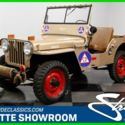 1946 CJ-2A Manual
1946 CJ-2A Manual
Mileage: 72,397
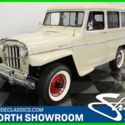 1956 Manual
1956 Manual
Mileage: 72,410
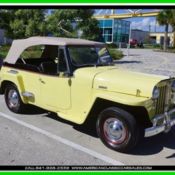 1948 Used Manual
1948 Used Manual
Mileage: 11,680
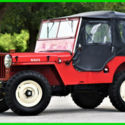 1947 Used Manual RWD
1947 Used Manual RWD
Mileage: 663
 1946 CJ-2A Used Manual
1946 CJ-2A Used Manual
Mileage: 72397
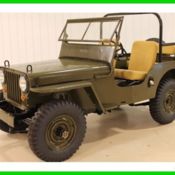 1947 Used Manual 4WD
1947 Used Manual 4WD
Mileage: 42,029
 1948 Used Manual RWD
1948 Used Manual RWD
 1960 Manual
1960 Manual
Mileage: 5504
 1953 Willys CJ-3B SUV Red 4WD Manual
1953 Willys CJ-3B SUV Red 4WD Manual
Mileage: 600
